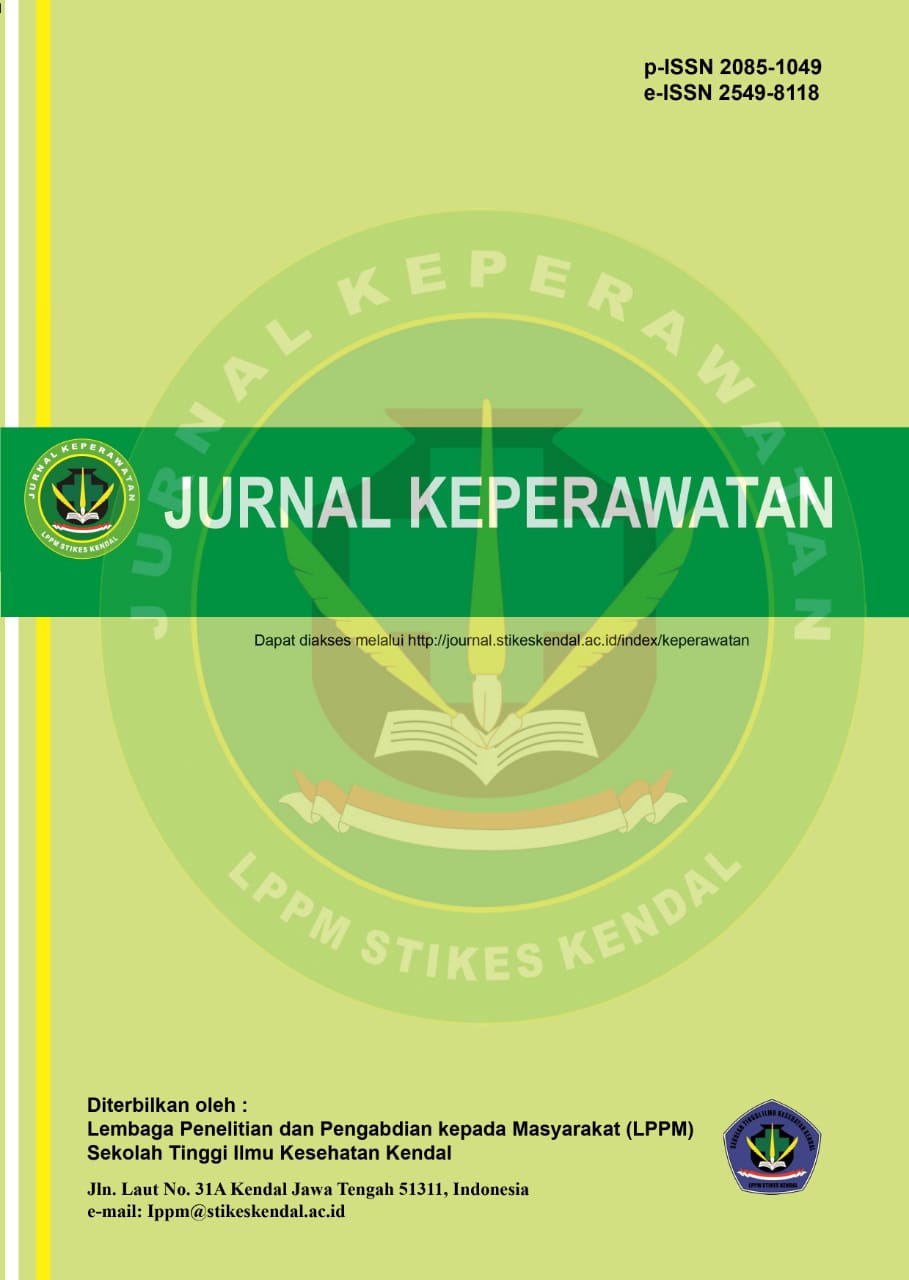Pengaruh Cognitive Behaviour Therapy dalam Menurunkan Kinesiophobia pada Pasien Post Operasi Total Knee Replacement
DOI:
https://doi.org/10.32583/keperawatan.v15i4.1817Keywords:
arthroplasty, cognitive behaviour therapy, kinesiophobia, knee replacementAbstract
Peningkatan jumlah penduduk akan memberikan dampak terhadap masalah kesehatan, salah satunya adalah lansia yang mengalami proses penuaan yang sedang dialami. Lansia yang mengalami proses penuaan akan lebih beresiko menderita penyakit degeneratif salah satunya adalah Osteoarthritis (OA). OA kronis akan dilakukan tindakan total knee replacement dan membutuhkan rehabilitasi yang tepat. Faktor yang mempengaruhi pasien post TKR untuk mobilisasi adalah ketakutan bergerak. Dengan kondisi ini menyebabkan seseorang post operasi TKR beresiko terhadap kekakuan otot dan mempengaruhi proses penyembuhan dan aktivitas setiap hari sehingga peneliti ingin mengetahui pengaruh cognitive behaviour therapy dalam menurunkan kinesiophobia pada pasien post operasi total knee replacement. Penelitian ini menggunakan metode quasy experiment dengan pendekatan pre test dan post test with control group. Dengan total sampel 15 responden untuk kelompok intervensi dan 15 responden untuk kelompok kontrol, Pengumpulan data menggunakan lembar observasi dan kuesioner tampa scale for kinesiophobia dengan nilai validitas 0,79 dan nilai reliabilitas 0,9 kemudian analisis data dilakukan dengan menggunakan paired t-test. Hasil penelitian menunjukkan bahwa kelompok intervensi memiliki nilai p-value 0,001 yang diartikan terdapat hubungan yang signifikan pada kelompok intervensi.
References
Agung, A. P., Priambodo, A., & Julianti, H. P. (2017). Perbedaan Jenis Total Knee Arthroplasty Terhadap Derajat Fungsional Lutut Dan Kualitas Hidup Pasien Osteoarthritis Lutut. Jurnal Kedokteran Diponegoro, 6(1), 1–11.
Ahmad, I. W., Rahmawati., Wardhana, H. (2018). Demographic Profile, Clinical and Analysis of Osteoarthritis Patients in Surabaya. Biomolecular and Health Science Journal. http://dx.doi.org/10.20473/bhsj.v1i1.8208
Ariza-Mateos, M. J., Cabrera-Martos, I., Ortiz-Rubio, A., Torres-Sánchez, I., Rodríguez-Torres, J., & Valenza, M. C. (2019). Effects of a Patient-Centered Graded Exposure Intervention Added to Manual Therapy for Women With Chronic Pelvic Pain: A Randomized Controlled Trial. Archives of Physical Medicine and Rehabilitation. https://doi.org/10.1016/j.apmr.2018.08.188
Aurelia RA, Putri SH, Ilmiawan MI, D. (2022). Faktor-Faktor yang Berhubungan dengan Kejadian Osteoarthritis Lutut pada Petani di Desa Bhakti Mulya Kecamatan Bengkayang. Jurnal Kedokteran dan Kesehatan, 18(1), https://jurnal.umj.ac.id/index.php/JKK.
Australia Orthopedic Assosiation. (2018). AOA Research Strategic Plan.
Bouchard, S., Robillard, G., Larouche, S., & Loranger, C. (2012). Description of a Treatment Manual for in virtuo Exposure with Specific Phobia. In Virtual Reality in Psychological, Medical and Pedagogical Applications. https://doi.org/10.5772/46417
Brown M L, Plate J F, Von Thaer S, et al. (2016). Decreased Range of Motion After Total Knee Arthroplasty Is Predicted by the Tampa Scale of Kinesiophobia[J]. J Arthroplasty,2016,31(4):793-797
Brown, O. S., Hu, L., Demetriou, C., Smith, T. O., & Hing, C. B. (2020). The effects of kinesiophobia on outcome following total knee replacement: a systematic review. Archives of Orthopaedic and Trauma Surgery. https://doi.org/10.1007/s00402-020-03582-5
Birch S, Stilling M, Mechlenburg I, et al. (2017). Effectiveness of a physiotherapist delivered cognitive-behavioral patient education for patients who undergoes operation for total knee arthroplasty: a protocol of a randomized controlled trial[J]. BMC Musculoskelet Disord,2017,18(1):116
Cai, L., Gao, H., Xu, Huiping., Wang, Y., Lyu, P., Liu, Y. (2017). Does a Program Based on Cognitive Behavioral Therapy Affect Kinesiophobia in Patients Following Total Knee Arthroplasty? A Randomized, Controlled Trial With a 6-Month Follow-Up. http://doi: 10.1016/j.arth.2017.10.035
CDC/National Center for Health Statistics. (2018). NHIS - About the National Health Interview Survey. April 9.
Center for Disease Control and Prevention. (2020). Osteoarthritis (OA).
Jentoft, E. S., Kvåle, A., Assmus, J., & Moen, V. P. (2020). Effect of information and exercise programmes after lumbar disc surgery: A randomized controlled trial. Physiotherapy Research International. https://doi.org/10.1002/pri.1864
Lu, G., Wu, T., Tan, Q., Wu, Z., Shi, L., & Zhong, Y. (2021). The effect of a micro-visual intervention on the accelerated recovery of patients with kinesiophobia after total knee replacement during neo-coronary pneumonia. Medicine. https://doi.org/10.1097/MD.0000000000024141
Goldsmith L J, Suryaprakash N, Randall E, et al. (2017). The importance of informational, clinical and personal support in patient experience with total knee replacement: a qualitative investigation[J]. BMC Musculoskelet Disord, 2017,18(1):127.510
Monticone M, Ferrante S, Teli M, et al. (2014) Management of catastrophising and kinesiophobia improves rehabilitation after fusion for lumbar spondylolisthesis and stenosis. A randomized controlled trial[J]. Eur Spine J, 2014,23(1):87-95
Monticone M, Ferrante S, Rocca B, et al. (2013). Effect of a long-lasting multidisciplinary program on disability and fear-avoidance behaviors in patients with chronic low back pain: results of a randomized controlled trial[J]. Clin J Pain, 2013,29(11):929-938.498
Oksuz S, Unal E.(2017). The effect of the clinical pilates exercises on kinesiophobia and other symptoms related to osteoporosis: Randomised controlled trial[J]. Complement Ther Clin Pract, 2017,26(2):68-72
Kurniawan., Rendy. A. F. (2019). Hubungan Usia Dengan Osteoartritis Lutut.
RISKESDAS. (2018). Riset Kesehatan Dasar 2018. Kementrian Kesehatan Republik Indonesia.
Downloads
Published
How to Cite
Issue
Section
License
Copyright (c) 2023 Jurnal Keperawatan

This work is licensed under a Creative Commons Attribution-NonCommercial-NoDerivatives 4.0 International License.



